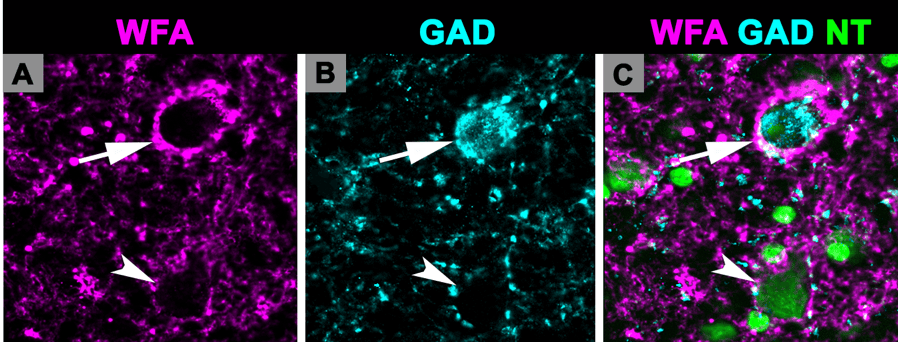Tiered Mentoring
with The University of Akron Department of Biology
 Age-related differences in GABAergic and perineuronal net expression in the central auditory system
Age-related differences in GABAergic and perineuronal net expression in the central auditory system
Dr. Jeffrey Mellott, Associate Professor of Anatomy and Neurobiology at NEOMED

Lab Overview:
Our lab examines GABAergic cells in aging auditory nuclei. As you age, inhibition is downregulated across the brain in both a compensatory and maladaptive fashion. In the auditory midbrain and auditory cortex, inhibition is initially downregulated to compensate for the loss of excitation due to damaged hair cells in the cochlea. However, the continued loss of inhibition at old age leads to what we call “central gain” (increased excitation), that contributes to temporal processing deficits/hearing loss in aged populations. One of our primary goals is to better understand how GABAergic cell populations, that are surrounded by unique protein structures called perineuronal nets, are altered with age in register with changes to hearing abilities.
To accomplish our goals we use a variety of anatomical and microscopic techniques. Specifically, for the proposal below, we will use immunohistochemistry, staining techniques, fluorescent microscopy, and a software package called Neurolucida to plot and characterize the cells of interest.
Background:
This project is brand new and born from a collaboration we have with Dr. Aravind Parthasarathy at the University of Pittsburgh. He has several experimental groups of gerbils with and without hearing loss (due to aging and noise exposure) and increased central gain. We will process the auditory midbrain and cortex (the two regions best known for their contribution to central gain) for GABAergic immunohistochemistry and stain the tissue for Neurotrace (to label all cells) and Wisteria Floribunda Agglutinin (WFA) to label what are called perineuronal nets. These “nets” are known to play a significant role in both synaptic and structural plasticity in the brain.
We have several publications on these techniques and questions; here is an article link if interested.
This project will serve to demonstrate two key results:
- There is a comparative aspect to the project. GABAergic cells and nets in the auditory midbrain and cortex have been examined in several species, but not gerbil. Gerbil is a common species for auditory experiments due to its lower frequency hearing abilities that mirrors human hearing. So it is important to determine if this commonly used species for auditory research aligns with other studies.
- Unlike these previous studies, the audiometric data for each gerbil/brain has been examined and collected, thus the anatomical and physiological data can be correlated which provides more robustness to the results of this study.
What will you be learning and doing if selected for the project?
The primary role will be to assist a current tiered mentoring student who is the lead for this project. The primary “job” is that you will learn how to use our fluorescent microscope and some basics of microscopy, learn how to identify various nuclei in the brain, and plot the GABAergic and non-GABAergic cells with and without nets. If your schedule is flexible enough, you will learn some basic immunohistochemistry and perhaps be trained to section the brains with a freezing microtome, and then learn how to mount sections on slide.
A number of other activities are likely to pop up, attending lab meetings, journal clubs, seminars, helping others in the lab rehearse poster presentations, and attending/presenting at NEOMED and/or Akron research days. Consistent and quality work may open the opportunity for a summer research fellowship.
Expectations and commitment
You will be expected to work in the lab at least 10 hours a week.
You will need your own transportation to and from NEOMED.
Once the training phase is over, you will be expected to largely work independently.
At the end of each week you will email me a very brief description of when you were in that week and what was accomplished.
